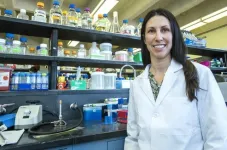(Press-News.org) BOSTON -- Billions of peripheral white blood cells are produced every day by the regular divisions of hematopoietic stem cells and their descendants in the bone marrow. Under normal circumstances, thousands of stem cells contribute progeny to the blood at any given time, making white blood cells a group with diverse ancestry.
Clonal hematopoiesis is a common age-related condition in which the descendants of one of these hematopoietic stem cells begin to dominate substantial portions of the blood. Genome-wide analyses have determined that clonal hematopoiesis is frequently driven by recurrent genetic alterations that confer a competitive advantage to specific hematopoietic stem cells, thus giving them the ability to expand disproportionately.
Multiple independent studies have shown that clonal hematopoiesis often goes hand in hand with atherosclerosis and cardiovascular disease. Since its discovery, this surprising association has been the subject of intense interest from clinicians and researchers alike.
Cardiovascular disease is the main cause of morbidity and mortality in Western countries and represents a massive public health burden. Do clonal expansions in the blood contribute to the progression of atherosclerosis, and if so, how?
Subsequent work showed that indeed, atherosclerotic plaque formation can be exacerbated by immune cells with clonal hematopoiesis-related mutations, thus raising the question whether clonal expansions in the blood should be targeted therapeutically for the prevention of cardiovascular disease.
In a new study published in Cell, researchers at Massachusetts General Hospital and Harvard Medical School now suggest a different, additional possibility: Atherosclerosis causes clonal hematopoiesis. Patients with atherosclerosis suffer from hyperlipidemia and inflammation, two conditions that are known to chronically boost hematopoietic stem cell division rates. In the new study, the researchers now demonstrate that this increased division accelerates the development of clonal hematopoiesis.
Kamila Naxerova, PhD, a principal investigator in MGH's Center for Systems Biology and senior author of the study, says: "Patients with atherosclerosis essentially experience 'accelerated time.' This is because the speed with which genetic alterations arise and spread through the hematopoietic system is determined by the underlying rate of stem cell division. From a genetic point of view, you could say that atherosclerosis accelerates aging of the blood. Since clonal hematopoiesis is an age-related condition, atherosclerosis patients are prone to developing it earlier than healthy individuals," says Naxerova, who is also an assistant professor of Radiology at Harvard Medical School.
Naxerova says that her team's findings may potentially be good news for patients with clonal hematopoiesis: "There is no doubt that more research is needed to carefully dissect the connection between clonal hematopoiesis and cardiovascular disease. But our results indicate that clonal hematopoiesis might in some cases only be a relatively harmless sign of an overactive hematopoietic system, and not a danger in itself."
"What makes this study unique is that the interdisciplinary team incorporated mathematical modeling to discover a new paradigm in the atherosclerosis field and further elucidated the interplay between cardiovascular disease and clonal hematopoiesis," says Michelle Olive, PhD, Program Officer in the Division of Cardiovascular Sciences at the National Heart, Lung, and Blood Institute, part of the National Institutes of Health.
INFORMATION:
The study was enabled by a close collaboration among geneticists, cardiovascular disease researchers and mathematicians funded by the National Heart, Lung, and Blood Institute (grant P01-HL142494).
About the Massachusetts General Hospital
Massachusetts General Hospital, founded in 1811, is the original and largest teaching hospital of Harvard Medical School. The Mass General Research Institute conducts the largest hospital-based research program in the nation, with annual research operations of more than $1 billion and comprises more than 9,500 researchers working across more than 30 institutes, centers and departments. In August 2020, Mass General was named #6 in the U.S. News & World Report list of "America's Best Hospitals."
COLUMBIA, Mo. - While physical activity is important for everyone, research has shown people with developmental disabilities do not exercise as often as their typically developed peers. In an effort to close this disparity, a researcher at the University of Missouri recently created fitness picture books that help youth with autism exercise more frequently while offering low-income families a simple resource for workout motivation when outdoor fitness equipment might not be accessible.
"There is so much research geared toward helping individuals with autism improve their academic ...
Treatments for beating tumours are mainly based on CD8 T lymphocytes, which specialise in detecting and eliminating intracellular infections and in killing cancer cells. A large proportion of patients, however, do not respond to these treatments. This prompted a research team from the Swiss Cancer Centre Léman (SCCL, Switzerland) to bring together the universities of Geneva (UNIGE) and Lausanne (UNIL), the Ludwig Institute for Cancer Research (LICR), EPFL and CHUV to investigate CD4 T lymphocytes. While these play a supporting role with CD8 T cells, their ability to eliminate tumour cells directly has been a matter of controversy. Using innovative nanoimaging technologies designed at the EPFL laboratory, the scientists found that when the CD4 T lymphocytes ...
The ocean floor is vast and varied, making up more than 70% of the Earth's surface. Scientists have long used information from sediments at the bottom of the ocean -- layers of rock and microbial muck -- to reconstruct the conditions in oceans of the past.
These reconstructions are important for understanding how and when oxygen became available in Earth's atmosphere and ultimately increased to the levels that support life as we know it today.
Yet reconstructions that rely on signals from sedimentary rocks but ignore the impact of local sedimentary processes do so at their own peril, according to geoscientists including David Fike in Arts & Sciences at Washington University in St. Louis.
Their new study published Feb. ...
Cells rely on membranes to protect themselves from the outside world. But these membranes can't be fully closed because nutrients and other molecules have to be able to pass through. To achieve this, cell membranes have many types of channels and pores. Also, there are receptors, antennas if you like, imbedded in the membrane that continuously monitor the outside world and signal to the cell interior. Extensive collaboration between five VIB groups resulted in a better understanding of the machinery that plants use to regulate the protein composition of their outer membrane. This discovery, published in Science Advances, enhances our basic knowledge of how the plasma membrane composition can be adapted based on external stimuli, an essential ...
A team of international researchers went back to the formation of the solar system 4.6 billion years ago to gain new insights into the cosmic origin of the heaviest elements on the period-ic table.
Led by scientists who collaborate as part of the International Research Network for Nuclear Astrophysics (IReNA) (irenaweb.org) and the Joint Institute for Nuclear Astrophysics - Center for the Evolution of the Elements (JINA-CEE) (jinaweb.org), the study is published in the lat-est issue of the journal Science (science.sciencemag.org/content/371/6532/945).
Heavy elements we encounter in our everyday life, ...
HOUSTON - (Feb. 26, 2021) - Save your silver! It's better used for jewelry than as a catalyst for drugs.
Rice University scientists have developed a greatly simplified method to make fluoroketones, precursors for drug design and manufacture that typically require a silver catalyst.
Rice chemist Julian West and graduate students Yen-Chu Lu and Helen Jordan introduced a process for the rapid and scalable synthesis of fluoroketones that have until now been challenging and expensive to make.
Their open-access work graces the cover of the Feb. 21 issue of the Royal Society of ...
Dropping out of high school, having schizophrenia, or being diagnosed with a co-occurring personality disorder increases the likelihood of someone becoming a "high utilizer" of inpatient psychiatric hospital services, according to a new study by researchers at The University of Texas Health Science Center at Houston (UTHealth). A high utilizer is someone who has been admitted three or more times within one year.
The research was published today in The Journal of Health Care for the Poor and Underserved.
For their findings, researchers used machine learning to analyze deidentified electronic ...
MISSOULA - University of Montana researchers and their partners have discovered a slimy strategy used by bacteria to defeat antibiotics and other drugs used to combat infections afflicting people with cystic fibrosis. The research was published Feb. 23 in the journal Cell Reports.
Cystic fibrosis is a life-threatening disease that causes persistent lung infections and limits a person's ability to breathe over time. A common strain of bacteria, Pseudomonas aeruginosa, often thrives in the lungs of people with cystic fibrosis, as well as in wounds from burns or diabetic ulcers. Once a P. aeruginosa infection is established, ...
Robots that could take on basic healthcare tasks to support the work of doctors and nurses may be the way of the future. Who knows, maybe a medical robot can prescribe your medicine someday? That's the idea behind 3D structural-sensing robots being developed and tested at Simon Fraser University by Woo Soo Kim, associate professor in the School of Mechatronic Systems Engineering.
"The recent pandemic demonstrates the need to minimize human-to-human interaction between healthcare workers and patients," says Kim, who authored two recent papers on the subject - a perspective on the technology and a demonstration of a robots' usefulness in healthcare. "There's an opportunity for sensing robots to measure ...
Parasitic flatworms known as agents of food-borne zoonoses were confirmed to use several species of thiarid snails, commonly found in freshwater and brackish environments in southeast Asia, as their first intermediate host. These parasites can cause severe ocular infections in humans who consume raw or improperly cooked fish that have fed on infected snails. The study, conducted in South Thailand by Thai and German researchers and led by Kitja Apiraksena, Silpakorn University, is published in the peer-reviewed open-access journal Zoosystematics and Evolution.
"Trematode infections are major public health problems affecting humans in southeast Asia," explain the scientists. "Trematode infections depend not only on the habit of people, but also on the presence of first ...







